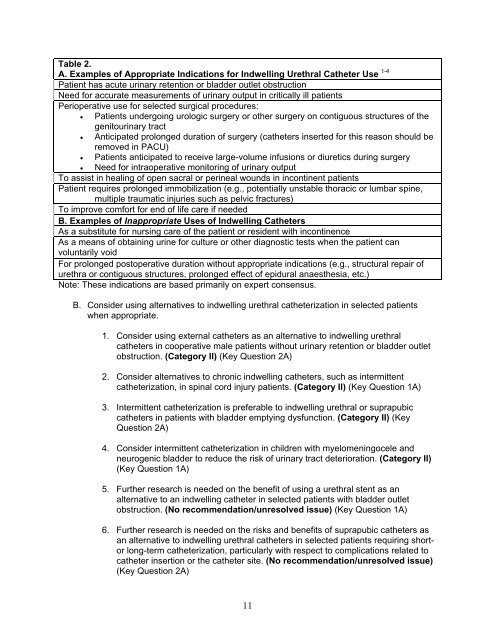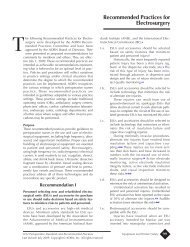2009 CAUTI guidelines - Centers for Disease Control and Prevention
2009 CAUTI guidelines - Centers for Disease Control and Prevention
2009 CAUTI guidelines - Centers for Disease Control and Prevention
Create successful ePaper yourself
Turn your PDF publications into a flip-book with our unique Google optimized e-Paper software.
Table 2.A. Examples of Appropriate Indications <strong>for</strong> Indwelling Urethral Catheter Use 1-4Patient has acute urinary retention or bladder outlet obstructionNeed <strong>for</strong> accurate measurements of urinary output in critically ill patientsPerioperative use <strong>for</strong> selected surgical procedures:• Patients undergoing urologic surgery or other surgery on contiguous structures of thegenitourinary tract• Anticipated prolonged duration of surgery (catheters inserted <strong>for</strong> this reason should beremoved in PACU)• Patients anticipated to receive large-volume infusions or diuretics during surgery• Need <strong>for</strong> intraoperative monitoring of urinary outputTo assist in healing of open sacral or perineal wounds in incontinent patientsPatient requires prolonged immobilization (e.g., potentially unstable thoracic or lumbar spine,multiple traumatic injuries such as pelvic fractures)To improve com<strong>for</strong>t <strong>for</strong> end of life care if neededB. Examples of Inappropriate Uses of Indwelling CathetersAs a substitute <strong>for</strong> nursing care of the patient or resident with incontinenceAs a means of obtaining urine <strong>for</strong> culture or other diagnostic tests when the patient canvoluntarily voidFor prolonged postoperative duration without appropriate indications (e.g., structural repair ofurethra or contiguous structures, prolonged effect of epidural anaesthesia, etc.)Note: These indications are based primarily on expert consensus.B. Consider using alternatives to indwelling urethral catheterization in selected patientswhen appropriate.1. Consider using external catheters as an alternative to indwelling urethralcatheters in cooperative male patients without urinary retention or bladder outletobstruction. (Category II) (Key Question 2A)2. Consider alternatives to chronic indwelling catheters, such as intermittentcatheterization, in spinal cord injury patients. (Category II) (Key Question 1A)3. Intermittent catheterization is preferable to indwelling urethral or suprapubiccatheters in patients with bladder emptying dysfunction. (Category II) (KeyQuestion 2A)4. Consider intermittent catheterization in children with myelomeningocele <strong>and</strong>neurogenic bladder to reduce the risk of urinary tract deterioration. (Category II)(Key Question 1A)5. Further research is needed on the benefit of using a urethral stent as analternative to an indwelling catheter in selected patients with bladder outletobstruction. (No recommendation/unresolved issue) (Key Question 1A)6. Further research is needed on the risks <strong>and</strong> benefits of suprapubic catheters asan alternative to indwelling urethral catheters in selected patients requiring shortorlong-term catheterization, particularly with respect to complications related tocatheter insertion or the catheter site. (No recommendation/unresolved issue)(Key Question 2A)11
















